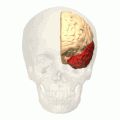Temporal lobe
(Redirected from Temporal lobes)
Temporal lobe
The Temporal lobe is one of the four major lobes of the cerebral cortex in the brain of mammals. The temporal lobe is located beneath the lateral sulcus and at roughly the same level as the ear. It plays a key role in processing sensory input and assigning it emotional meaning. It is also involved in visual memory, language comprehension, and emotion association.
Anatomy[edit | edit source]
The temporal lobe is located on the side of the brain, beneath the lateral fissure. It is divided into two main areas: the superior temporal gyrus, which includes the primary auditory cortex, and the inferior temporal gyrus, which includes the primary visual cortex.
Function[edit | edit source]
The temporal lobe is involved in several functions of the body including auditory perception, memory, and speech. It is also responsible for processing sensory input into derived meanings for the appropriate retention of visual memory, language comprehension, and emotion association.
Auditory perception[edit | edit source]
The primary auditory cortex is responsible for the processing of sounds. Specific sound frequencies are processed in specific regions of the auditory cortex.
Memory[edit | edit source]
The temporal lobe is critical for memory. The hippocampus, located in the temporal lobe, is particularly important in the consolidation of information from short-term memory to long-term memory.
Speech[edit | edit source]
The temporal lobe is involved in the processing of semantics in both speech and vision. The Wernicke's area, located in the superior temporal gyrus in the dominant cerebral hemisphere, which is the left hemisphere in about 95% of right-handed individuals and 70% of left-handed individuals, is responsible for the comprehension of speech.
Clinical significance[edit | edit source]
Damage to the temporal lobe can result in a variety of disorders including auditory agnosia, Wernicke's aphasia, amnesia, and Alzheimer's disease.
See also[edit | edit source]
References[edit | edit source]
Search WikiMD
Ad.Tired of being Overweight? Try W8MD's NYC physician weight loss.
Semaglutide (Ozempic / Wegovy and Tirzepatide (Mounjaro / Zepbound) available. Call 718 946 5500.
Advertise on WikiMD
|
WikiMD's Wellness Encyclopedia |
| Let Food Be Thy Medicine Medicine Thy Food - Hippocrates |
Translate this page: - East Asian
中文,
日本,
한국어,
South Asian
हिन्दी,
தமிழ்,
తెలుగు,
Urdu,
ಕನ್ನಡ,
Southeast Asian
Indonesian,
Vietnamese,
Thai,
မြန်မာဘာသာ,
বাংলা
European
español,
Deutsch,
français,
Greek,
português do Brasil,
polski,
română,
русский,
Nederlands,
norsk,
svenska,
suomi,
Italian
Middle Eastern & African
عربى,
Turkish,
Persian,
Hebrew,
Afrikaans,
isiZulu,
Kiswahili,
Other
Bulgarian,
Hungarian,
Czech,
Swedish,
മലയാളം,
मराठी,
ਪੰਜਾਬੀ,
ગુજરાતી,
Portuguese,
Ukrainian
Medical Disclaimer: WikiMD is not a substitute for professional medical advice. The information on WikiMD is provided as an information resource only, may be incorrect, outdated or misleading, and is not to be used or relied on for any diagnostic or treatment purposes. Please consult your health care provider before making any healthcare decisions or for guidance about a specific medical condition. WikiMD expressly disclaims responsibility, and shall have no liability, for any damages, loss, injury, or liability whatsoever suffered as a result of your reliance on the information contained in this site. By visiting this site you agree to the foregoing terms and conditions, which may from time to time be changed or supplemented by WikiMD. If you do not agree to the foregoing terms and conditions, you should not enter or use this site. See full disclaimer.
Credits:Most images are courtesy of Wikimedia commons, and templates, categories Wikipedia, licensed under CC BY SA or similar.
Contributors: Prab R. Tumpati, MD


